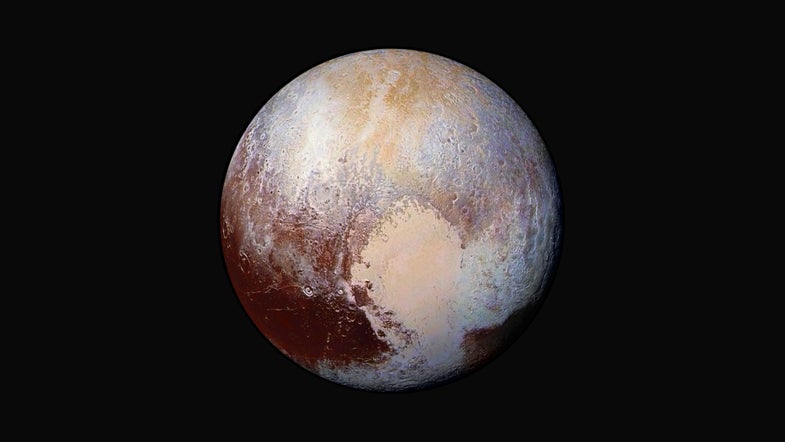Pluto’s frozen heart may hide an ocean inside
The heavy heart may have tipped the world over

Talk about a change of heart. Sputnik Planitia, the icy plain that forms part of Pluto’s “heart,” has dramatically changed places since it was created 4 billion years ago.
According to two new papers in Nature, Sputnik Planitia has traveled about 745 miles southeast of its original location. “The same reorientation on Earth—granted Earth is larger than Pluto—would be like taking North America and South America and swapping places,” says James Keane, a PhD candidate at the University of Arizona and lead author on one of the papers.

About-Face
What’s more, the plain’s dramatic location change supports the theory that Pluto once had a liquid ocean beneath its icy surface, and may still have one today.
Gravity tug
Scientists think the 600-mile-wide basin beneath Sputnik Planitia was carved out by a large impact about 4 billion years ago. Over the following millennia, the basin’s floor was buried in miles of frozen nitrogen, methane, and carbon monoxide, transforming the basin into a vast, icy plain.
Keane’s team and another research group noticed that this basin is located in a special place on Pluto—near its equator, on the side of the world that always faces the moon Charon. The teams think this location is no coincidence. If Sputnik Planitia is a particularly heavy patch of terrain, gravity may have pulled it to this area over millions or billions of years.
As a sphere spins, momentum tends to push heavier patches to the sphere’s equatorial region, where it’s spinning fastest. So if the plain has a high mass, it may have gotten tugged toward Pluto’s equator.
But that’s not the only force at work here. Sputnik Planitia is positioned pretty close to Pluto’s tidal axis, the imaginary line that connects the center of Pluto to the center of Charon. Charon’s gravity tugs at Pluto’s surface here, which could have helped to nudge the plain along during its migration.
The researchers think that the vast basin wasn’t born in the spot where it’s currently located, but rather migrated there over time, pulling the dwarf planet’s entire icy shell along with it. The process is thought to have occurred on other bodies in the past, including Europa, Enceladus, Mars, and the Moon.
Etched in ice
Cracks in the ice all over Pluto support the hypothesis that Sputnik Planitia underwent a long-distance migration. They also suggest Pluto had a liquid ocean beneath its frozen crust, which may have helped the entire crust to slip into its new location.
Pluto’s cracks indicate that the dwarf planet’s crust has been expanding, says Keane, and the easiest way to account for that is with a subsurface ocean. As water from the ocean bubbled up to Pluto’s surface, it would freeze and expand, just like ice cubes in a tray, leaving faults behind.

Pluto’s fault lines
Normally the fault lines that come from regular freezing and expansion would be oriented in random ways. But on Pluto, most of the faults seem to point to one place: Sputnik Planitia. These fault lines, combined with computer models by the researchers, indicate that the plain’s position has dramatically changed over time, moving southeast from its original position by as much as 60 degrees.
Whose fault?
Sputnik Planitia would have only been pulled to its new location if it’s a particularly heavy part of Pluto’s surface. But normally a basin such as this would have less mass than the surrounding areas, because it’s been hollowed out.
Keane’s team suggested that the basin’s thick layers of ice, deposited over millions or billions of years, combined with ejecta from the impact that created the basin, might have made Sputnik Planitia heavy enough to migrate.
But a second team of researchers led by Francis Nimmo, a planetary scientist from the University of California at Santa Cruz, thinks an inner ocean is a more likely explanation.
“Without a subsurface ocean, a positive gravity anomaly requires an implausibly thick nitrogen layer,” his team writes in their paper.
Nimmo explained in an email that the impact that created the basin removed a lot of ice from the surface. Removing all that weight would mean that the upward force of the subsurface ocean would be stronger than the weight bearing down on it, so the ocean would push up a bit. That oceanic bulge could be what added enough weight to send Sputnik Planitia drifting to its new location.
Still moving
Sputnik Planitia is currently located about 250 miles from Pluto’s tidal axis, and it may be migrating in the same direction today.
If ices are still accumulating on the plain, Keane says, that means they’re still adding weight, and continuing to force Sputnik Planitia toward the tidal axis.
And intriguingly, Nimmo says the plains’ current location may be evidence that a liquid ocean still lingers beneath Pluto’s surface.
“If the ocean completely re-froze, that would remove one source of excess mass, so Sputnik Planitia would reverse course and move back away from the equator,” he says. “Since it is pretty close to the equator now, it can’t have moved very far back (if at all), so that makes me think there is probably an ocean there now.”
If Pluto does have a subsurface ocean, scientists aren’t sure how it has remained warm enough to stay in liquid form. The radioactive heating that would have originally melted ice near Pluto’s core should have burnt out long ago, and the gravitational deformations from Charon aren’t enough to warm the core.
Although it would be great to send a spacecraft to investigate these mysteries, that isn’t likely to happen in the next decade or so.
But Keane is hopeful that the answers may lie in the New Horizons spacecraft, which flew by the dwarf planet last year and only just finished sending its data home. Better images of Pluto’s fault lines may provide more information about their age and how far Sputnik Planitia has moved. And other New Horizons data could provide valuable information about Pluto’s current climate and how volatiles are circulating and depositing as ices.
“There are still a lot of things to look at,” Keane says. “The data is going to keep people occupied for many decades to come.”